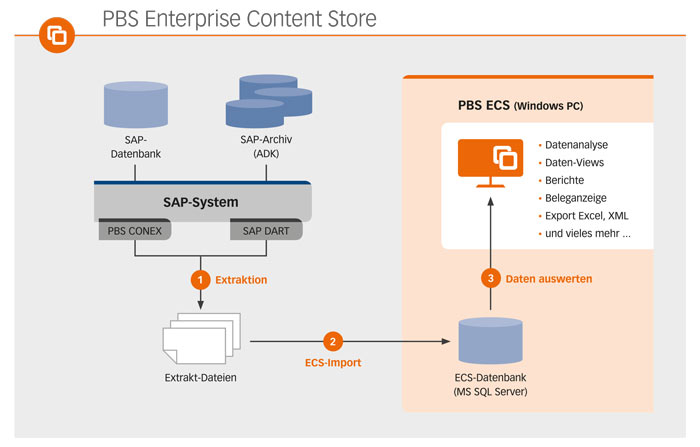Shutting Down Legacy SAP Systems


Companies have always been looking for ways to shut down SAP systems as soon as they no longer have to be permanently available. Decommissioning is always accompanied by the expectation of cost reduction. Operating and licensing costs can be saved, for example, when the company is sold as a whole or in parts, restructured, but also when changing from R/2 to R/3 or ERP ECC—or now when switching to the Hana-based S/4.
If a legacy system is replaced by a new system environment based on a greenfield approach, it is always necessary to keep certain data after the system has been shut down In addition, data must be made available for various analytical purposes, e.g. for tax- , social security- and internal audits, data analysis, product liability purposes and more.
Determining which data from a database or a legacy system must still be available in detail after an SAP system is shut down is a highly challenging task. As a rule of thumb, a team from different departments must be responsible for a project like this. This project may also involve an external consulting firm that provides extensive knowledge or experience in the area of SAP system shutdowns. Companies need to be aware that simply extracting all data from a legacy system in order to be able to use it in the future is not very practical for reasons of cost and effort.
The time and effort involved in a SAP system shutdown can vary considerably. Some projects may be completed in ten days, but they can also take up to 100 workdays or more, depending on the affected departments or the diversity of SAP data that is to be extracted. In any case, it is best to deal with this challenge at an early stage in the project, preferably right when deciding to shut down legacy system or before the start of S/4 Hana migration projects.
Tailored to SAP
As one of few SAP partners worldwide, PBS Software has been providing a supplementary solution specifically for SAP system shutdowns as part of its product portfolio for Information Lifecycle Management for years. Like all SAP add-on solutions, it is sold by PBS and its partners or used by partner companies or consulting firms in SAP projects.
PBS offers a slim and economical standard solution. It is an alternative to the SAP ILM solution, with which SAP attempts to cover SAP system shutdowns. With the SAP solution, even the most comprehensive decommissioning requirements can be implemented, but it still requires functioning SAP applications such as ERP and BW. In contrast, the PBS solution does not require a running legacy system after shutdown.
The PBS solution essentially consists of two components: On the one hand, the so-called PBS Content Extractor (CONEX) ensures that data can be extracted from SAP systems in a transparent format. On the other hand the second component, the PC/Windows-based PBS Enterprise Content Store (ECS), ensures that the extracted data can be managed, protected, filtered, displayed or also used for analysis in specifically prepared views.
A major advantage of the solution: the provision of easy-to-use functions for handling or evaluating SAP data and thus the possibility for even non-SAP users to carry out data retrieval operations in a simple manner.
Transparency is key
What does standard software mean in this context? What is special about the PBS solution for SAP system shutdowns? A procedure is used for the extraction of data that has been standardized, proven many times over and thus ensures transparency. Extraction objects are created and used to match the respective application data in the SAP environment. Specifically, usable objects are generated or created, for example, an FI document, an SD document or dedicated objects for production data.
Custom objects—Z tables
Custom objects can also be created. That means additional tables, especially customer-specific—so-called “Z tables”—can be included in the extraction. It is also possible to integrate SAP archive files (ADK) into the extraction. In addition to table data, companies have the option of integrating or transferring non-structured information like documents and print lists from existing DMS solutions via a reference system. These are then also available in the PBS Enterprise Content Store after the legacy system has been turned off.
SAP DART files for company audits
ECS can also import and process SAP DART files. Many customers use DART to generate data extracts for the transfer of relevant data for tax audits. Generally speaking, the PBS Enterprise Content Store provides considerably more functionalities than a conventional storage system. With the PBS solution, you can display and navigate through SAP tables or SAP data, further process these datasets or use them for a wide variety of different purposes.
Printing and creating Excel files are just a few examples in this regard. Transaction-like SAP document display based on SAP transactions or using the data for analytics are other possibilities (also with predefined views for SAP data evaluation or in connection with analytics tools like SAP Crystal Reports or SQL Server Business Intelligence).
Of course, there are also check- or test functions that ensure that the data extractions performed correspond exactly to what you have agreed on—in addition to far-reaching user administration and access control (for SAP documents, print lists and extracts).
According to requirements
When it comes to pulling the plug on SAP systems, one thing is clear: After extracting the data from a legacy system, the Content Extractor is not required permanently for data extraction. That is exactly why the solution is offered as rental software.
The situation naturally is different for the other component, the Enterprise Content Store, into which the SAP data was imported. It is used or operated as long as the respective data must be kept available. If some of the data is no longer needed, it can simply be deleted from the database. The rule of thumb in this case is: the longer the data is kept, the better. After all, you never really know how long certain data is really needed. PBS is currently evaluating the possibility of making this component available as a cloud solution in the future.
To conclude, the standard solution PBS offers for shutting down legacy SAP systems is suitable for all SAP systems or modules (including industry-specific solutions) and has already proven itself in numerous national and international projects.
SAP shutdown concrete:
Sale of a business unit
Practically with the decision of a medium-sized company (around 200 employees, approximately 50 million euros in sales) to sell a business unit, the issue was to decommission an SAP ECC system. At the same time, the manufacturing company, which does not wish to be named, had a requirement to remove relevant SAP data from the system. These were to continue to be available for a certain period of time after the decommissioning. Primarily for retention reasons. Everything went as planned. Approximately 40,000 invoice documents from a DMS, around 700 HR master records and several thousand travel receipts (HR data) were extracted or transferred to the PBS Enterprise Content Store using the PBS solution CONEX. The project only took ten man-days, which meant that the implementation costs could easily be kept within the given budget limits.









1 comment
hort
Wegen Stilllegung, wenn immer Wartung läuft, sap verlangt gesamte Vertrag. Das ist eine Falle von SAP und Gewinn für Sie. Warum bringen Sie Firmen dazu.